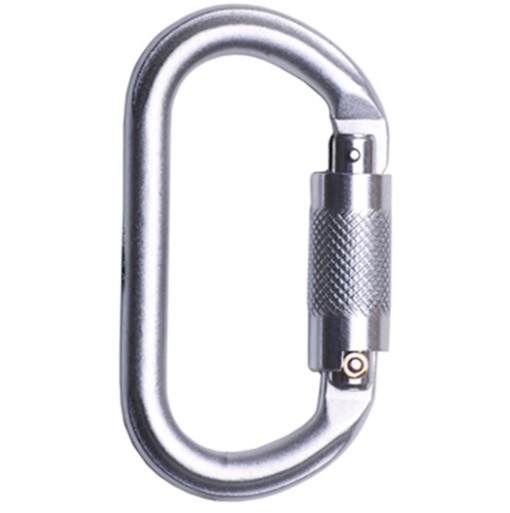
There are 4 main karabiner types, each of which uses a different locking mechanism: screw gate karabiners, twist lock karabiners, triple lock karabiners and pin lock karabiners. Click the below links to skip to the relevant section and learn about each karabiner type.
-
-
-
-
Here at SafetyLiftinGear, we stock a wide range of karabiners for use in fall protection systems. Whether you're working at height or just climbing in your leisure time, our sturdy and secure karabiners can help you to stay safe.
Karabiners used at work must have a 'double action' gate opening and locking function as a minimum. This ensures an extra level of security against unintentional opening and disengagement during use.
But with a variety of different locking mechanisms and karabiner types to choose from, you may well ask: which option is best?
Listed below are some of the most common karabiner locking options. Before purchasing your karabiners, think carefully about the conditions in which you'll be using them and the type of work you're likely to be doing. If in doubt, feel free to contact the SafetyLiftinGear team for expert advice.
1. Screw gate karabiners (double action)
Screw gate karabiners (also known as screw lock karabiners) are secured by manually screwing them shut. When the locking mechanism is screwed into position, it prevents the gate from opening.
Watch the video below to see this type of karabiner in action. The product being demonstrated is the AZ011 Screw Lock Karabiner.
Manual-locking screw gate karabiners are fairly popular because they are easy to use (it's possible to lock and unlock the gate with just one hand) and because they can be relied upon even in challenging conditions.
However, a manual locking system like this has some obvious drawbacks. The screwing / unscrewing action takes time and effort, and it's possible that a user may completely forget to secure the karabiner before using it.
While unlikely, there is also a minor risk that the screw lock might come loose if it repeatedly rubs against a rough surface or if strong vibrations cause the thread to move on its own.
2. Twist lock karabiners (double action)

At a glance, twist lock karabiners (also known as automatic karabiners) look quite similar to screw lock karabiners - but while a screw lock has to be manually screwed into place, a twist lock will automatically close into the locked position when the gate springs shut. To open the karabiner, you have to twist the gate before it can be pulled open. The gate will automatically close and lock as soon as it's released.
A twist lock has several advantages over the more traditional screw lock mechanism:
- No fear of forgetting to lock the karabiner.
- The karabiner is instantly secured - no time or effort required.
- Unlocking the karabiner also takes less time, making it ideal in situations where regular repositioning is required.
3. Triple lock karabiners (triple action)

You know how we mentioned that twist lock karabiners are sometimes called 'double action' karabiners because two movements (a twist and a push) are required to open the gate? Well, there's another type of karabiner called 'triple action' karabiners that take three movements to unlock.
Take the PETZL M33TL Triple Action Karabiner, for example: the gate barrel must be pushed up, twisted, THEN pulled open. This extra step makes the karabiner even more secure and makes it almost impossible for the gate to be opened unintentionally.
4. Pin lock karabiners

Pin lock karabiners like the PETZL M34APL are supplied with a small unlocking tool. The karabiner cannot be unlocked without the unlocking tool, making it a great option for groups where additional control measures may be required to ensure the karabiner is not removed.
A pin lock karabiner is a great option to ensure the user cannot become disconnected from the fall protection system. This karabiner type is very common in leisure activities such as climbing walls and high ropes courses, as it gives the instructor peace of mind knowing the user cannot remove their own karabiner.
*
While these are the most common karabiner types, other locking options do exist. For example, we can provide ball lock karabiners with triple action locking and a coloured lock indicator that makes it easy to tell whether or not the karabiner is secure. Click the link below to browse our full range.
Buy Locking Karabiners >>

